- Clone
- OX-104 (See other available formats)
- Regulatory Status
- RUO
- Workshop
- VII 70655
- Other Names
- OX-2, OX2
- Isotype
- Mouse IgG1, κ
- Ave. Rating
- Submit a Review
- Product Citations
- publications

-

Human peripheral blood lymphocytes were stained with CD4 APC and CD200 (OX2) (clone OX-104) Purified (left) or Mouse IgG1, κ isotype control (right) followed by Biotin anti-Mouse IgG and Streptavidin-PE. -

Recombinant biotinylated hCD200 (Black circles, Cat. No. 770206) binds to immobilized recombinant hCD200R (Cat. No. 770106). Anti-hCD200 antibody (Clone OX-104, Purple squares) inhibits the binding in a dose-dependent manner. This antibody blocks binding of 40 ng/mL of hCD200 biotinylated protein to 0.5 µg/mL immobilized recombinant hCD200R with an ND50 = 0.4 - 2 µg/mL.
| Cat # | Size | Price | Quantity Check Availability | Save | ||
|---|---|---|---|---|---|---|
| 329226 | 100 µg | $248 | ||||
| 329227 | 1 mg | $715 | ||||
CD200, also known as OX2, is a member of the immunoglobulin superfamily (IgSF). It is a monomorphic cell surface glycoprotein that is expressed on thymocytes, neurons, endothelium, follicular dendritic cells in all lymphoid organs, a subset of CD34+ progenitor cells, and at low levels on some smooth muscle and B lymphocytes. It is not expressed on NK cells, monocytes, granulocytes, or platelets. CD200 costimulates T cell proliferation. It may regulate myeloid cell activity in a variety of tissues. The interaction between CD200 (OX2) and CD200 receptor (OX2R) system is of importance in the control of macrophage and granulocyte activation, which may contribute to pathways that suppress and limit macrophage induced inflammatory damage in tissue.
Product DetailsProduct Details
- Verified Reactivity
- Human
- Reported Reactivity
- African Green, Baboon
- Antibody Type
- Monoclonal
- Host Species
- Mouse
- Formulation
- 0.2 µm filtered in phosphate-buffered solution, pH 7.2, containing no preservative.
- Endotoxin Level
- Less than 0.01 EU/µg of the protein (< 0.001 ng/µg of the protein) as determined by the LAL test.
- Preparation
- The Ultra-LEAF™ (Low Endotoxin, Azide-Free) antibody was purified by affinity chromatography.
- Concentration
- The antibody is bottled at the concentration indicated on the vial, typically between 2 mg/mL and 3 mg/mL. Older lots may have also been bottled at 1 mg/mL. To obtain lot-specific concentration and expiration, please enter the lot number in our Certificate of Analysis online tool.
- Storage & Handling
- The antibody solution should be stored undiluted between 2°C and 8°C. This Ultra-LEAF™ solution contains no preservative; handle under aseptic conditions.
- Application
-
FC - Quality tested
Block - Verified
IHC-F, IHC-P - Reported in the literature, not verified in house - Recommended Usage
-
Each lot of this antibody is quality control tested by immunofluorescent staining with flow cytometric analysis. For flow cytometric staining, the suggested use of this reagent is ≤ 2.0 µg per million cells in 100 µl volume. For blocking application, the ND50 range: 0.4 - 2.0 µg/mL. It is recommended that the reagent be titrated for optimal performance for each application.
- Application Notes
-
Additional reported applications (for the relevant formats) include: immunohistochemistry of formalin-fixed paraffin-embedded sections1 and acetone-fixed frozen sections2, and blocking of CD200 interaction with CD200R.
-
Application References
(PubMed link indicates BioLegend citation) -
- Patel GK, et al. 2012. J. Invest. Dermatol. 132:401. (IHC)
- Wright GJ, et al. 2001. Immunology 102:173. (IHC)
- Foster-Cuevas M, et al. 2004. J. Virol. 78:7667. (FC)
- RRID
-
AB_2810502 (BioLegend Cat. No. 329226)
AB_2810503 (BioLegend Cat. No. 329227)
Antigen Details
- Structure
- Immunoglobulin superfamily
- Distribution
-
T cells, neurons, endothelium
- Function
- Costimulates T cell proliferation
- Receptors
- CD200R
- Cell Type
- Endothelial cells, Neurons, T cells
- Biology Area
- Cell Biology, Costimulatory Molecules, Immunology, Neuroscience, Neuroscience Cell Markers
- Molecular Family
- CD Molecules
- Antigen References
-
1. Wright GJ, et al. 2001. Immunol. 102:173.
2. Foster-Cuevas M, et al. 2004. J. Virol. 78:7667.
3. Mason D, et al. 2002. ed. Leukocyte Typing VII. New York:Oxford Univ. Press.
4. Broderick C, et al. 2002. Am. J. Pathol. 161:1669. - Regulation
- Induces a downregulation of macrophage activity
- Gene ID
- 4345 View all products for this Gene ID
- UniProt
- View information about CD200 on UniProt.org
Related Pages & Pathways
Pages
Related FAQs
- Do you guarantee that your antibodies are totally pathogen free?
-
BioLegend does not test for pathogens in-house aside from the GoInVivo™ product line. However, upon request, this can be tested on a custom basis with an outside, independent laboratory.
- Does BioLegend test each Ultra-LEAF™ antibody by functional assay?
-
No, BioLegend does not test Ultra-LEAF™ antibodies by functional assays unless otherwise indicated. Due to the possible complexities and variations of uses of biofunctional antibodies in different assays and because of the large product portfolio, BioLegend does not currently perform functional assays as a routine QC for the antibodies. However, we do provide references in which the antibodies were used for functional assays and we do perform QC to verify the specificity and quality of the antibody based on our strict specification criteria.
- Does BioLegend test each Ultra-LEAF™ antibody for potential pathogens?
-
No, BioLegend does not test for pathogens in-house unless otherwise indicated. However, we can recommend an outside vendor to perform this testing as needed.
- Have you tested this Ultra-LEAF™ antibody for in vivo or in vitro applications?
-
We don't test our antibodies for in vivo or in vitro applications unless otherwise indicated. Depending on the product, the TDS may describe literature supporting usage of a particular product for bioassay. It may be best to further consult the literature to find clone specific information.
Other Formats
View All CD200 Reagents Request Custom ConjugationCompare Data Across All Formats
This data display is provided for general comparisons between formats.
Your actual data may vary due to variations in samples, target cells, instruments and their settings, staining conditions, and other factors.
If you need assistance with selecting the best format contact our expert technical support team.
-
Purified anti-human CD200 (OX2)

Human peripheral blood lymphocytes were stained with CD4 APC... -
Biotin anti-human CD200 (OX2)
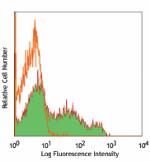
Human peripheral blood lymphocytes stained with biotinylated... -
PE anti-human CD200 (OX2)

Human peripheral blood lymphocytes stained with OX-104 PE -
APC anti-human CD200 (OX2)
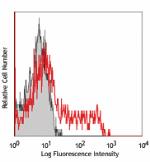
Human peripheral blood lymphocytes stained with OX-104 APC -
Brilliant Violet 421™ anti-human CD200 (OX2)

Human peripheral blood lymphocytes were stained with CD200 (... -
PE/Cyanine7 anti-human CD200 (OX2)
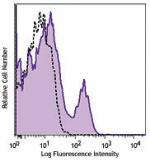
Human peripheral blood lymphocytes were stained with CD200 (... -
Alexa Fluor® 647 anti-human CD200 (OX2)

Human peripheral blood lymphocytes were stained with CD200 (... -
PerCP/Cyanine5.5 anti-human CD200 (OX2)

Human peripheral blood lymphocytes were stained with CD4 APC... -
Brilliant Violet 605™ anti-human CD200 (OX2)
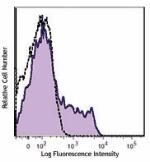
Human peripheral blood lymphocytes were stained with CD200 (... -
Purified anti-human CD200 (OX2) (Maxpar® Ready)

Human PBMCs stained with 149Sm-anti-CD200 (OX-104). B cells ... -
APC/Cyanine7 anti-human CD200 (OX2)

Human peripheral blood lymphocytes were stained with CD4 APC... -
Brilliant Violet 711™ anti-human CD200 (OX2)

Human peripheral blood lymphocytes were stained with CD200 (... -
APC/Fire™ 750 anti-human CD200 (OX2)

Human peripheral blood lymphocytes were stained with CD200 (... -
Ultra-LEAF™ Purified anti-human CD200 (OX2)
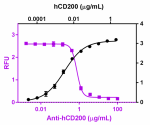
Recombinant biotinylated hCD200 (Black circles, Cat. No. 770... 
Human peripheral blood lymphocytes were stained with CD4 APC... -
TotalSeq™-C0447 anti-human CD200 (OX2)
-
TotalSeq™-D0447 anti-human CD200 (OX2)
-
TotalSeq™-A0447 anti-human CD200 (OX2)
-
TotalSeq™-B0447 anti-human CD200 (OX2)
-
Spark YG™ 581 anti-human CD200 (OX2)

Human peripheral blood lymphocytes were stained with anti-hu... -
PE/Fire™ 700 anti-human CD200 (OX2)

Human peripheral blood lymphocytes were stained with anti-hu...
 Login/Register
Login/Register 









Follow Us